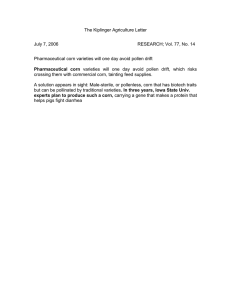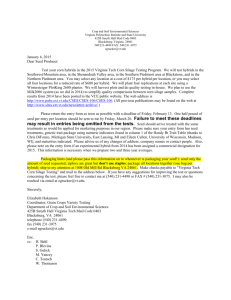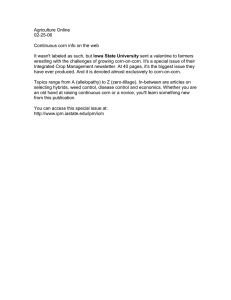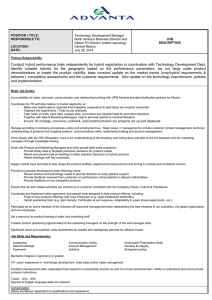by
advertisement
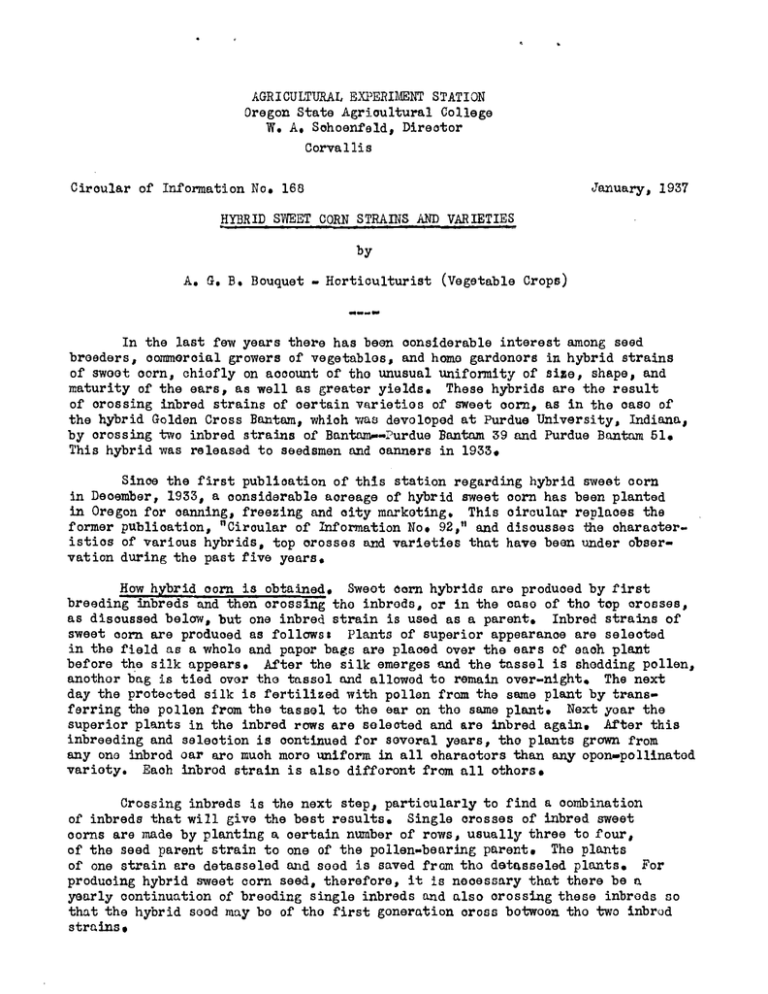
AGRICULTURAL EXPERIMENT STATION Oregon State Agricultural College W. A. Sohoenfeld, Director Corvallis January, 1937 Circular of Information No. 165 HYBRID SVEET CORN STRAINS AND VARIETIES by A. G. B. Bouquet Horticulturist (Vegetable Crops) In the last few years there has been considerable interest among seed breeders, oorenoroial growers of vegetables, and home gardeners in hybrid strains of sweet corn, ohiofly on a000unt of tho unusual uniformity of size, shape, and maturity of the ears, as we].1 as greater yields. These hybrids are the result of crossing inbred strains of certain varieties of sweet corn, as in the case of the hybrid Golden Cross Bantam, whioh tas developed at Purdue University, Indiana, by crossing two inbred strains of Bantam..-.2urdue anttun 39 and Purdue Bantam 51. This hybrid was released to seedsznen and oanners in 1933. Since the first publication of this station regarding hybrid sweet corn in December, 1933, a considerable aoreage of hybrid sweet corn has been planted in Oregon for canning, freezing and city marketing. This circular replaces the 92, and discusses the characterformer publication, "Circular of Information No, isties of various hybrids, top crosses and varieties that have been under observation during the past five years. How hybrid oem is obtained. Sweat corn hybrids are produced by first breeding inbreds and then crossing tho inbrods, or in the case of the top crosses, as discussed below, but one inbred strain is used as a parent. Inbred strains of sweet corn are produced as follaws: Plants of superior appearance are solootod in the field as a whole and paper bags are placed over the ears of each plant before the silk appears. After the silk emerges and the tassel is shedding pollen, another bag is tied over the tassel and allowed to remain over-night. The next day the protected silk is fertilized with pollen from the same plant by trans.ferring the pollen from the tassel to the ear on the same plant. Next year the superior plants in the inbred rows are soleoted and are inbred again. After this inbreeding and selection is continued for several years, the plants grown from any one inbred oar are much more uniform in all ohara&cors than any opon-pollinatod variety. Each imbrod strain is also different from all others. Crossing inbrods is the next step, particularly to find a combination of inbreds that will give the best results. Single crosses of inbred sweet corns are made by planting a certain number of rows, usually three to four, of the seed parent strain to one of the pollen-bearing parent. The plants of one strain are detassoled and seed is saved from the detassoled plants. For producing hybrid sweet corn seed, therefore, it is necessary that there be a yearly continuation of brooding single imbreds and also crossing these inbrods so that the hybrid seed may be of the first generation cross botwoon the two inbrod strains, 2. Double crosses are produced by taking first generation hybrids resulting from two single crosses, which are then crossed together; therefore, a double cross strain will have four inbrods entering into it. Three way crosses are those in which three single inbrods have boon crossed or a singlo hybrid will again be crossed with another inbred, making it a so-called three way cross. Top crosses. Some of the strains of sweet corn are offered as top crosses, In growing a top cross an inbred is used as a male parent and the regular variety, open pollinated, as a fomalo instoad of using the two inbrods, as in the case of the single hybrid previously described. In the case of the top cross, therefore, only one of the parents is an inbred strain, consequently there is liable to be more variation in the top crosses than the hybrids, in which two inbreds are the parents. Do Not Save Seed From Hybrid. Growers of sweet corn hybrids are often inclined to save some of the attraoIvo uniform hybrid oars for sood, They should consider the fact that the seed from tho hybrids is not pure for the difforont characters except thothat are ooninon to both parents, and therefore, the plants grown from tho second generation seed are more variable, usually less- vigorous and less productive than those of the first generation hybrid. A grower cannot select seed from a orop of an inbred cross and oxpoot to reproduce the sane results as in planting newly crossed seed, It is, therefore, necessary for the sweet corn grower to go back to his soedsman each year for a necessary supply of hybrid seed. Ordinary sweet corn seed from open.pollinated fields costs about 16 to 17 cents a pound, and if 10 to 12 pounds of seed are planted per acre, the cost of seed per aoro would be between l.60 to 2.0O. Hybrid sweot corn seed is expected to cost about 30 to 35 cents per pound in 1937, thus entailing a cost of t3.O0 to 4.O0 per acre. The difference between the two seed items is but 1l.40 to 2.0O per acre which should be roimbursod several times by the inoroasod yield of the hybrid corn over that of the open pollinated variety. The Experiment Station may be able to suggest sources of seed. Recent developments in hybrids. lNhen hybrid sweet corn was introduced a few years ago, there were but two or theo varieties de'veloped, among the most important of which was Golden Cross Bantam. Since the introduction and wido use of this variety a large number of hybrids have boon propagated in which inbred lines of different varieties have been used, So many different hybrids and crosses of various kinds have boon developed by breeders of late that the grower may be more or less bewildered by the number that he may find listed in seed catalogs, The mere mention of the word hybrid swoot corn now includes an inoreasingly large number of two.'way crosses, top crosses, triple and fourway crosses and there is apparently no end to the possible development of crosses of one strain or variety with another. Those strains differ in color of kernel, number of days to the first harvest, length and diameter of ear, and number of rows of kernels and many other characters. The tendency of breeders has been to propagate earlier strains in view of the fact that the first hybrid introduced, nsanely Golden Cross Ban-barn, is quito a number of days later than the oponpollinatod variotioa of early swoot corn. Most hybrids, as a matter of fact, are a few days later than the varieties 3. from which they were developed and few, if any, of the hybrids are as early as the earliest varieties. In some of the early top crosses, there is little difference botwon their season and that of the original parent. It is entirely possible that within a relatively short time hybrids will be developed that are as early in season as the earliest varieties, It is probable that at the present time there are as many different strains of hybrids as there are varieties of oponpol1inatod corn. It is likewise important that the grower of sweet corn who buys hybrid. eeed realizes that strains of one hybrid may vary to a considerable extent in ylold, uniformity, and trueness to type. For oxamplo, in a test of 8 strains of Golden Cross Bantam, the number of ears per acre varied from 12,000 to 16,600 and the tonnage of green corn from 4.3 to 6.2 tons. As in the case of opon-.poflinated varieties, therefore, it is emphasized that the hybrid is good only in proportion to the knowledge, skill and care that goes into its breeding and seed production and that the purity and performance of the hybrid are directly influenced by care taken in breeding the inbred parents, crossing the strains and preventing oon.tamjnation with other lots of corn. 0pen..Pollinatod Varieties The varieties listed herewith are not inbred. Some may be varieties of crossed corn, such as the first variety named, but the parents of the cross are not 5.nbreds. Golden Early Market. One of the largest of the early varieties, being approximately 80 days from seeding to harvest. It is a crossed corn but not an inbred hybrid, the parents of Golden Early Market being Golden Bantam and Early Vhite Market. It is about 12 to 14 days earlier than Golden Bantam. The oars are large and generally twelve rowed. Golden Gem. Also one of the earliest yellow kernel varieties, and general.ly about 78 to 8 days to harvest. The ears are eight to ten rowed, small to In field trials this variety produced a medium sized, with excellent quality. high number of marketable oars per acre0 In trials was about an 85day variety, producing small Spanish Gold. to medium, fine quc.lity ears mostly ten to twelve rowed. Not a heavy producer marketable ears of a good strain of Golden Bantam, and yielding in trials but 6 Golden Sunshine. This variety was 84 to 87 days reaching a state of first harvestinj ears largi, yellow, and twelve rowed, but there was considerable variation in ear characters and ths yield of ears per acre was comparatively low, being less than the best strain of Golden Bantam, Golden Bantam. Strains vary considerably in season, character of ears, uniformity, and yield. Most Bantam strains take 85 to 92 days to harvest. Ears vary from 8 to 12 rows of kernels, small to medium sized, and generally the strains are quite highly productive with a fair to moderately good percentage of marketable sarsj quality excellent. 4. Goldam Giant, This is a eras sod corn between Golden Bantam and Howling Mob, but i is nà an inbred hybrid; plants large; ears large, but rather being about 102 to 105 days to harvest; a fine variety for a main or late crop. late, Bantam Evergreen. A crossed corn between Golden Bantam and Stowoll's Evorgreoibut not anirod hybrid. Slightly later in the season than Golden Bantam, The oars are usually 12 to 16 rowed, 8 inches long and the plants moderately productive. Toj, Crosses As previously stated, top crosses consist of the progeny resulting from the cross of an open.'pollinatod varioty, such as any of the varieties just mentioned, as the female parent and an inbred line of a variety as the male parent. Spanoross P.39, for example, is a cross of Spanish Gold and an inbred strain Purdue 39 which is one of the parents of Golden Cross Bantam. The number of top crosses that have been developed of late has been large, Some have shown distinctly greater uniformity and larger yields than the open-pollinated variety from which the top cross was made, but others have been inferior. In view of the large number of top crosses that have been bred and have been tested at Corvallis, the number here discussed will be confined to a few examples. only a few of which Gem Cross P.39. This is one of the earliest top crosses, being about 82 to 85 days to. harvest, mostly 10 to 12 rowed. This variety was reported on favorably in cooperative trials In Olaoksxnas County. the earliest Sanoross P.39. A top crossed Spanish Gold and also one of hybrids, aout ten days later than the original variety but larger, more UflIE. form and productive of a greater yield and a higher percentage of marketable ears; 8 to 12 rowed. Sunoross P.39. This is a top cross of Golden Sunshine with Purdue 39, In cooperative trials but later in maturity than the two previous top crosses. in Claokamas County It was approximately 98 days to time of first harvesting. (Top Cross Golden Bantam) There are a number of different Banoross. op crosses of Golden Bantam, depending on which inbred has been strains of used as the male parent of the top-cross. A few days later than Golden Bantam, In Corvallis trials did not exceed In number of ears the best strain of Golden Bantam. ybrids Golden Cross Bantam. This is the first introduced and most widely grown of the iiibred crosses, It Is a single cross produced by crossing two inbred strains of yellow corn, both products of the United States Deparnent of Agriculture and the Indiana Agricultural Experiment Station. Its histroy and description are given in the circular named below. 5. In field tests on the Experiment Station grounds at Corvallis there was an unusual uniformity of height and vigor of plants as well as length and diameter of ears, An excellent ear of this first generation hybrid was 8 inches long, 2 inches in diameter at the butt end, 12 rowed and weighing unhusked, approximately 9 to 10 ounces. There were comparatively few oulla in the population of ears. The plants are unusually vigorous and uniform in growth and there is greater uniformity of maturity of the oars than is ordinarily found in open.'pollinated varieties. Season later than the early varieties and early top...orosses being about 100 days to harvest. Valuable for a main crop and for canning. Now generally grown in various districts of the state for delivery to canneries and freezing plants. Booaue of the larger foliage and generally greater vigor of the plant, it does beat when gown in good soil and preferably with irrigation under which oirouxnstanoos it is not uncommon to obtain a yield of 5 to 6 tons pox' acre. Kingscsrost. This hybrid is an strains of Golden Bantam, two single othex'. In tests at Corvallis, a typi 7 to 7 inches in length, and l inoh very uniform in this respect. There in ear characters in general. Season Golden Bantam, example of a double cross of inbred osses of inbreds being crossed with each ally good oar of Hingsorost measured from a at the butt end, strictly 8 row, being as a pronounced uniformity of this hybrid early, being several days earlier than Addjtiona!1 Publications on Hybrid Sweet Corn. Golden Cross Bantam Sweet Corn, The What and How of Hybrid Corn. Circ. 268, U.S.D.A., Washington, D.C. Farmers' Bul, No. 1744, U.S.D.A. (These two publications may be obtained at a price of 51 each from the Supt. of Documents, Washington, D.C.) Suckered and Unsuokered Sweet Corn. Ciro, of Information No. US, Oregon Agricultural Experiment Station, Corvallis, Oregon.
